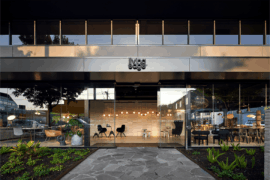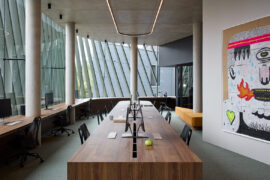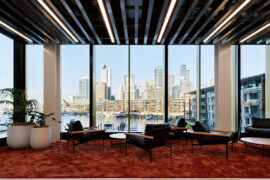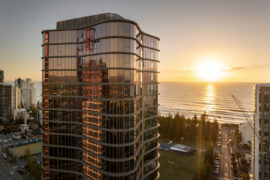Now open at NGV Australia, Civilization: The Way We Live Now is a photographic exploration of the globalised world – including people, movement and of course buildings.
The twenty-first century is a complex place – mass globalisation, ongoing development of the built environment, a collapsing of perceived proximity – these are just some of the topics explored in the NGV Australia’s latest exhibition Civilization: The Way We Live Now.
The international photography exhibition brings together over 200 original photographic works by a selection of 100 contemporary photographers from across the world.
Setting the tone for the show, co-curator William Ewing says: “What is the definition of civilization? The word only goes back to 1756, so it’s a relatively new addition but it’s an important imperative because the level of global anxiety has never been quite what it is.”
Opening the exhibition, Assistant Director of the NGV Isobel Crombie said: “The show has a strong thematic message based around a critical contemporary message – what does a twenty-first century, global civilization look like?
“The exhibition explores photographers’ representation of the phenomenal complexity of civilization with a labyrinthine journey into the shared aspects of urban life. At the heart of this exhibition is an attempt to identify the shared human experiences, the similarities in how we live, work, dream, fail and learn.”
The exhibition is curated into eight key themes, topics that offer a glimpse into the state of the very early part of civilization in the twenty-first century, essentially putting a lens on the shared experiences of life in the urban environment.
Taken from Tom Wolfe’s Bonfire of the Vanities, the Hive section opens the show by looking at how people compress and how crowds ebb and flow within the built environment. This section offers a pictorial view of the hive mentality in action – intricate, detailed and expressive.
As loneliness continues to rise, the space in which humans inhabit shrinks around us. Despite living in closer proximity the digitised world is putting screens in front of us creating a sense of isolation, a timely topic given visual reference in this theme.
The mass movement of people around the world and the systems that hold them up shape the Flow theme, showing what impact these systems have on our depersonalised relationship with food, material goods and nature.
The influence of advertising, religion, business and politics comes to life in this theme featuring the work of photographers such as Andreia Alves de Oliveira, Sato Shintaro, Amalia Ulman and Alec Soth.
Explores the reach of governing bodies around the world and our desire to impose increasing structure on how our civilization develops through governments and their armies, surveillance, architecture, education and business.
Confronting and raw, the Rupture theme shows some of the failures of the world with images of detention centres, the flow of refugees, border crossings and environmental degradation.
Travel is a mainstay of the modern world, Escape questions this desire with images of cruise ships, sports events, outdoor pursuits and dance floors.
Closing the exhibition is a look at what could be around the corner. Next looks into the future to offer a clear snapshot of the right now and how technological advancements are pushing civilization forward.
Civilization: The Way We Live Now is co-curated by Holly Roussel and William Ewing and presented in collaboration with the Foundation for the Exhibition of Photography, Minneapolis/New York/Paris/Lausanne and the National Museum of Modern and Contemporary Art, Korea.
Civilization: The Way We Live Now is Open 2 February 2020
The Ian Potter Centre: NGV Australia at Federation Square
INDESIGN is on instagram
Follow @indesignlive
A searchable and comprehensive guide for specifying leading products and their suppliers
Keep up to date with the latest and greatest from our industry BFF's!

For Aidan Mawhinney, the secret ingredient to Living Edge’s success “comes down to people, product and place.” As the brand celebrates a significant 25-year milestone, it’s that commitment to authentic, sustainable design – and the people behind it all – that continues to anchor its legacy.

London-based design duo Raw Edges have joined forces with Established & Sons and Tongue & Groove to introduce Wall to Wall – a hand-stained, “living collection” that transforms parquet flooring into a canvas of colour, pattern, and possibility.

Community, Country and climate were centred at the 2025 Australian Institute of Landscape Architects (AILA) Awards in Lutruwita/Tasmania on 21st October.

Smart Design Studio and Those Architects combine landmark and workplace in Bundarra, a Surry Hills gateway blending old and new.
The internet never sleeps! Here's the stuff you might have missed

Warren and Mahoney’s design for Beca’s Auckland headquarters turns the mechanics of engineering into poetry, rethinking how workplace design can reveal its own systems.

Completed in 2025, Marella by Mosaic is a 30-storey residential tower in Broadbeach designed by Plus Studio. The project brings sculptural form, ocean views and hotel-style amenities together in a refined expression of coastal living.